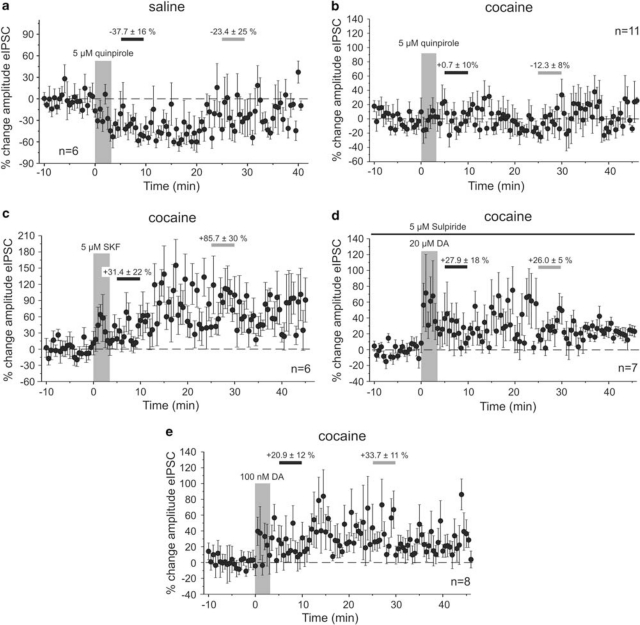Figure 2.
Pharmacology of DA effects on eIPSCs in saline-treated and cocaine-sensitized animals. (a) Bath application of the D2-type receptor agonist quinpirole (5 μM) induced a rapid reduction in eIPSC amplitude in saline-treated animals. The graph shows the time course of eIPSC amplitude changes relative to the averaged response of the baseline period. In all graphs, the large vertical bar indicates the period of drug application. Horizontal bars indicate the periods from which averaged measures were used for statistical comparisons of ‘early' (black) and ‘late' (gray) drug effects, and the numbers indicate the mean (±SEM) percentage change in amplitude during these 5 min periods. (b) Activation of D2-type receptors in cocaine-treated animals (n=11) failed to induce a similar reduction in eIPSC amplitude as seen in saline animals. The differential responses to quinpirole in the two treatment groups parallel the effects of DA on the transient reduction in eIPSCs amplitude in saline- and cocaine-treated animals, respectively. (c, d) In contrast to D2 receptor activation, D1 receptor activation is unaltered in cocaine-treated rats. Bath application of the D1 agonist SKF-81297 (c) or of DA (20 μM) in the presence of the D2 receptor antagonist sulpiride (d) evoked a rapid and persistent increase in the amplitude of the eIPSCs (n=7). Sulpiride was present in the bath for the duration of the recording (black line). (e) Bath application of a low dose (100 nM) of DA also results in an immediate and long-lasting increase in eIPSC amplitude. Low concentrations of DA (<1 μM) were previously reported to preferentially activate D1 receptors (Trantham-Davidson et al, 2004). See text for details.

